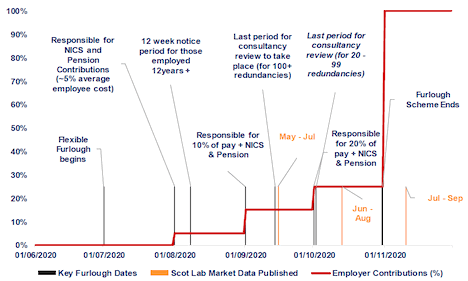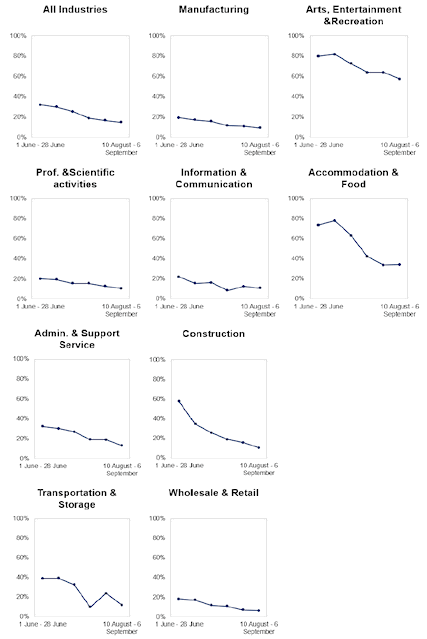Coronavirus (COVID-19) - extending the Coronavirus Job Retention Scheme: analysis
Paper exploring the costs and benefits of extending the Coronavirus Job Retention Scheme on a temporary basis. Such an extension could reduce unemployment in Scotland by 61,000 through the first half of 2021, at a cost of around £850 million.
The Uptake and Impact of the CJRS to Date
Under the UK’s CJRS, furloughed workers receive 80% of their wages, up to £2,500 per month. Until the end of July, this was paid entirely by the UK Government and employers were allowed to voluntarily top up that amount.
The UK Government’s support is being phased out in a tapered way, with employers required to pay employers’ NICs and pension contributions (around 5% of employment costs) in August; 10% of wages in September; and 20% in October. Employees will see no change to their wage subsidy. The scheme is due to close on 31 October 2020.
Chart 2 below provides a timeline that highlights critical decision / information points for employers with regard to the CJRS.
It is expected that as employer contributions increase over time and as we approach the end of the formal scheme, the end point will become a cliff edge by which time firms must make decisions on staff retention. For those obligated to hold specific consultation periods for redundancies, the last point is beginning of October.
These key dates work back from the end of the CJRS at the end of October. Some employers may already have made or are currently making retention decisions prior to these dates. Given the high number of furloughed workers, the closure of CJRS presents a cliff edge that could precipitate a surge in unemployment in the second half of the year.

Source: HM. Treasury; ONS
To date, 9.6 million jobs in the UK have been protected by the Coronavirus Job Retention Scheme at some point since March. Data published by HMRC show that the scheme has protected 779,500 Scottish jobs, or around 32% of the total Scottish workforce. As the economy has reopened, the number of people on the scheme has fallen, but more than 217,000 jobs in Scotland are still estimated to be furloughed according to survey data.
Scottish Government earlier analysis[1] shows that the CJRS, alongside the other measures taken, is playing a key role in mitigating the impact of the shock on unemployment. While the full outlook remains uncertain we have estimated that the CJRS alone is responsible for keeping the unemployment rate between 3 to 4 percentage points lower than it otherwise would have been, as well as helping to prevent and longer-term “scarring” to the labour market.
Our modelling also suggests that the UK Government’s fiscal policy response to date could have prevented Scottish GDP falling by a further 5% in Q2. This highlights the importance of not unwinding the current support schemes too quickly and also removing demand from the economy at the moment when it is most critical to supporting the recovery.
However, the coverage and cost of the scheme have fallen as more sectors of the economy are opening up and demand returns, with 6.8 million furloughed across the UK at the end of June. Analysis of survey data for Scottish businesses (Chart 3) shows that the rate has continued to fall across sectors. While there is no publically available estimate of the number of people on furlough since June, ONS survey responses suggest that in the second half of August around 15 per cent of employees in surveyed businesses in Scotland were on furlough leave as furloughed employees have returned to work.
Some sectors have been unable to resume economic activity and have faced large turnover shocks (see Annex A). As we move into a new phase of the pandemic, with cases of Covid-19 rising it may still prove to be impossible for certain sectors to resume economic activity in a way that is economically viable before the current employment support schemes are due to expire in October 2020. Sectors that may require further emergency support beyond October include, but may not be limited to, tourism and hospitality, arts and culture, oil and gas, childcare, and retail.

Source: ONS; SG Analysis
Contact
Email: OCEABusiness@gov.scot
There is a problem
Thanks for your feedback